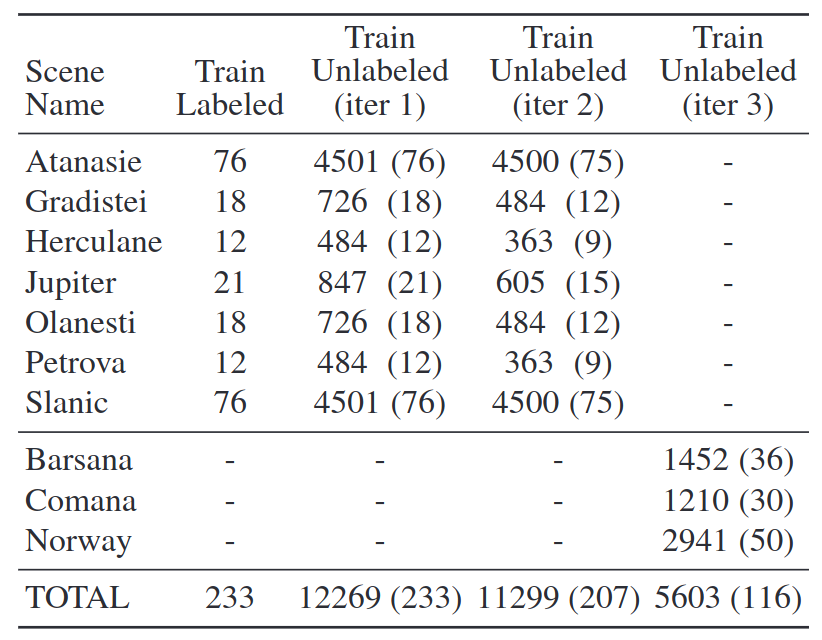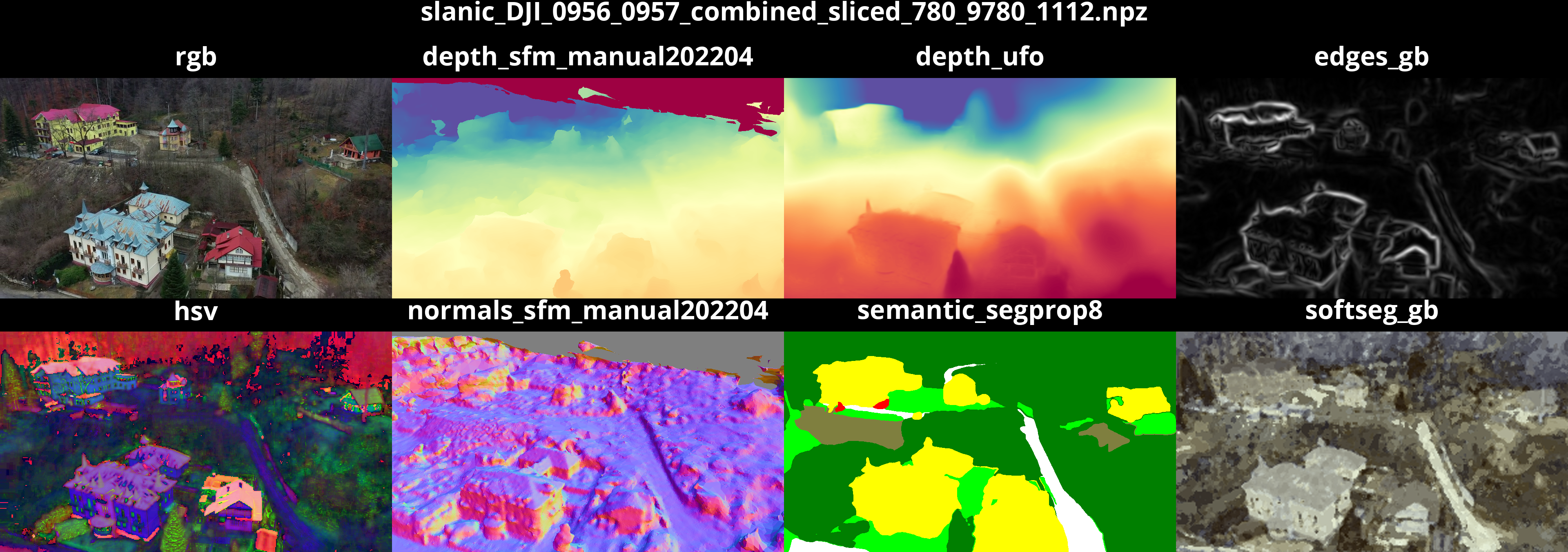The dataset viewer is not available because its heuristics could not detect any supported data files. You can try uploading some data files, or configuring the data files location manually.
Dronescapes dataset
As introduced in our ICCV 2023 workshop paper: link
Note: We are extending this dataset in another repository. GT data for benchmarking is the same, but we are generating modalities as inputs: dronescapes-2024.
1. Downloading the data
git lfs install # Make sure you have git-lfs installed (https://git-lfs.com)
git clone https://huggingface.co/datasets/Meehai/dronescapes
Note: the dataset has about 200GB, so it may take a while to clone it.
1.2 Low level data for the dataset (GPS, camera rotation matrices)
Click to expand
1.2.1 Convert Camera Normals to World Normals
This is an optional step, but for some use cases, it may be better to use world normals instead of camera normals, which
are provided by default in normals_sfm_manual202204. To convert, we provide camera rotation matrices in
raw_data/camera_matrics.tar.gz for all 8 scenes that also have SfM.
In order to convert, use this function (for each npz file):
def convert_camera_to_world(normals: np.ndarray, rotation_matrix: np.ndarray) -> np.ndarray:
normals = (normals.copy() - 0.5) * 2 # [-1:1] -> [0:1]
camera_normals = camera_normals @ np.linalg.inv(rotation_matrix)
camera_normals = (camera_normals / 2) + 0.5 # [0:1] => [-1:1]
return np.clip(camera_normals, 0.0, 1.0)
1.2.2 Raw camera location
The GPS location (lat/long/height) is in the raw_data/raw_camera_info.tar.gz. Each file over there is an archive over the
original videos, so the train/val/test splits files from raw_data/txt_files must be used to map to proper indices. Each
archive contains a bunch of raw data, however the key lat_long_height should provide the GPS location.
Note: there is no GPS for the norway scene, the log seems to have been lost.
2. Using the data
As per the split from the paper:

The data is in the data* directory with 1 sub-directory for each split above (and a few more variants).
The simplest way to explore the data is to use the provided notebook. Upon running it, you should get a collage with all the default tasks, like this:
For a CLI-only method, you can use the provided reader as well:
python scripts/dronescapes_viewer.py data/test_set_annotated_only/ # or any of the 8 directories in data/
Expected output
[MultiTaskDataset]
- Path: '/export/home/proiecte/aux/mihai_cristian.pirvu/datasets/dronescapes/data/test_set_annotated_only'
- Tasks (11): [DepthRepresentation(depth_dpt), DepthRepresentation(depth_sfm_manual202204), DepthRepresentation(depth_ufo), ColorRepresentation(edges_dexined), EdgesRepresentation(edges_gb), NpzRepresentation(normals_sfm_manual202204), OpticalFlowRepresentation(opticalflow_rife), ColorRepresentation(rgb), SemanticRepresentation(semantic_mask2former_swin_mapillary_converted), SemanticRepresentation(semantic_segprop8), ColorRepresentation(softseg_gb)]
- Length: 116
- Handle missing data mode: 'fill_none'
== Shapes ==
{'depth_dpt': torch.Size([540, 960]),
'depth_sfm_manual202204': torch.Size([540, 960]),
'depth_ufo': torch.Size([540, 960, 1]),
'edges_dexined': torch.Size([540, 960]),
'edges_gb': torch.Size([540, 960, 1]),
'normals_sfm_manual202204': torch.Size([540, 960, 3]),
'opticalflow_rife': torch.Size([540, 960, 2]),
'rgb': torch.Size([540, 960, 3]),
'semantic_mask2former_swin_mapillary_converted': torch.Size([540, 960, 8]),
'semantic_segprop8': torch.Size([540, 960, 8]),
'softseg_gb': torch.Size([540, 960, 3])}
== Random loaded item ==
{'depth_dpt': tensor[540, 960] n=518400 (2.0Mb) x∈[0.043, 1.000] μ=0.341 σ=0.418,
'depth_sfm_manual202204': None,
'depth_ufo': tensor[540, 960, 1] n=518400 (2.0Mb) x∈[0.115, 0.588] μ=0.297 σ=0.138,
'edges_dexined': tensor[540, 960] n=518400 (2.0Mb) x∈[0.000, 0.004] μ=0.003 σ=0.001,
'edges_gb': tensor[540, 960, 1] n=518400 (2.0Mb) x∈[0., 1.000] μ=0.063 σ=0.100,
'normals_sfm_manual202204': None,
'opticalflow_rife': tensor[540, 960, 2] n=1036800 (4.0Mb) x∈[-0.004, 0.005] μ=0.000 σ=0.000,
'rgb': tensor[540, 960, 3] n=1555200 (5.9Mb) x∈[0., 1.000] μ=0.392 σ=0.238,
'semantic_mask2former_swin_mapillary_converted': tensor[540, 960, 8] n=4147200 (16Mb) x∈[0., 1.000] μ=0.125 σ=0.331,
'semantic_segprop8': tensor[540, 960, 8] n=4147200 (16Mb) x∈[0., 1.000] μ=0.125 σ=0.331,
'softseg_gb': tensor[540, 960, 3] n=1555200 (5.9Mb) x∈[0., 0.004] μ=0.002 σ=0.001}
== Random loaded batch ==
{'depth_dpt': tensor[5, 540, 960] n=2592000 (9.9Mb) x∈[0.043, 1.000] μ=0.340 σ=0.417,
'depth_sfm_manual202204': tensor[5, 540, 960] n=2592000 (9.9Mb) NaN!,
'depth_ufo': tensor[5, 540, 960, 1] n=2592000 (9.9Mb) x∈[0.115, 0.588] μ=0.296 σ=0.137,
'edges_dexined': tensor[5, 540, 960] n=2592000 (9.9Mb) x∈[0.000, 0.004] μ=0.003 σ=0.001,
'edges_gb': tensor[5, 540, 960, 1] n=2592000 (9.9Mb) x∈[0., 1.000] μ=0.063 σ=0.102,
'normals_sfm_manual202204': tensor[5, 540, 960, 3] n=7776000 (30Mb) NaN!,
'opticalflow_rife': tensor[5, 540, 960, 2] n=5184000 (20Mb) x∈[-0.004, 0.006] μ=0.000 σ=0.000,
'rgb': tensor[5, 540, 960, 3] n=7776000 (30Mb) x∈[0., 1.000] μ=0.393 σ=0.238,
'semantic_mask2former_swin_mapillary_converted': tensor[5, 540, 960, 8] n=20736000 (79Mb) x∈[0., 1.000] μ=0.125 σ=0.331,
'semantic_segprop8': tensor[5, 540, 960, 8] n=20736000 (79Mb) x∈[0., 1.000] μ=0.125 σ=0.331,
'softseg_gb': tensor[5, 540, 960, 3] n=7776000 (30Mb) x∈[0., 0.004] μ=0.002 σ=0.001}
== Random loaded batch using torch DataLoader ==
{'depth_dpt': tensor[5, 540, 960] n=2592000 (9.9Mb) x∈[0.025, 1.000] μ=0.216 σ=0.343,
'depth_sfm_manual202204': tensor[5, 540, 960] n=2592000 (9.9Mb) x∈[0., 1.000] μ=0.562 σ=0.335 NaN!,
'depth_ufo': tensor[5, 540, 960, 1] n=2592000 (9.9Mb) x∈[0.100, 0.580] μ=0.290 σ=0.128,
'edges_dexined': tensor[5, 540, 960] n=2592000 (9.9Mb) x∈[0.000, 0.004] μ=0.003 σ=0.001,
'edges_gb': tensor[5, 540, 960, 1] n=2592000 (9.9Mb) x∈[0., 1.000] μ=0.079 σ=0.116,
'normals_sfm_manual202204': tensor[5, 540, 960, 3] n=7776000 (30Mb) x∈[0.000, 1.000] μ=0.552 σ=0.253 NaN!,
'opticalflow_rife': tensor[5, 540, 960, 2] n=5184000 (20Mb) x∈[-0.013, 0.016] μ=0.000 σ=0.004,
'rgb': tensor[5, 540, 960, 3] n=7776000 (30Mb) x∈[0., 1.000] μ=0.338 σ=0.237,
'semantic_mask2former_swin_mapillary_converted': tensor[5, 540, 960, 8] n=20736000 (79Mb) x∈[0., 1.000] μ=0.125 σ=0.331,
'semantic_segprop8': tensor[5, 540, 960, 8] n=20736000 (79Mb) x∈[0., 1.000] μ=0.125 σ=0.331,
'softseg_gb': tensor[5, 540, 960, 3] n=7776000 (30Mb) x∈[0., 0.004] μ=0.002 σ=0.001}
3. Evaluation for semantic segmentation
We evaluate in the paper on the 3 test scenes (unsees at train) as well as the semi-supervised scenes (seen, but
different split) against the human annotated frames. The general evaluation script is in
scripts/evaluate_semantic_segmentation.py.
General usage is:
python scripts/evaluate_semantic_segmentation.py y_dir gt_dir -o results.csv --classes C1 C2 .. Cn
[--class_weights W1 W2 ... Wn] [--scenes s1 s2 ... sm]
Script explanation
The script is a bit convoluted, so let's break it into parts:y_dirandgt_dirTwo directories of .npz files in the same format as the dataset- y_dir/1.npz, ..., y_dir/N.npz
- gt_dir/1.npz, ..., gt_dir.npz
classesA list of classes in the order that they appear in the predictions and gt filesclass_weights(optional, but used in paper) How much to weigh each class. In the paper we compute these weights as the number of pixels in all the dataset (train/val/semisup/test) for each of the 8 classes resulting in the numbers below.scenesif they_dirandgt_dircontains multiple scenes that you want to evaluate separately, the script allows you to pass the prefix of all the scenes. For example, indata/test_set_annotated_only/semantic_segprop8/there are actually 3 scenes in the npz files and in the paper, we evaluate each scene independently. Even though the script outputs one csv file with predictions for each npz file, the scenes are used for proper aggregation at scene level.
Reproducing paper results for Mask2Former
python scripts/evaluate_semantic_segmentation.py \
data/test_set_annotated_only/semantic_mask2former_swin_mapillary_converted/ \ # Mask2Former example, use yours here!
data/test_set_annotated_only/semantic_segprop8/ \
-o results.csv \
--classes land forest residential road little-objects water sky hill \
--class_weights 0.28172092 0.30589653 0.13341699 0.05937348 0.00474491 0.05987466 0.08660721 0.06836531 \
--scenes barsana_DJI_0500_0501_combined_sliced_2700_14700 comana_DJI_0881_full norway_210821_DJI_0015_full
Should output:
scene iou f1
barsana_DJI_0500_0501_combined_sliced_2700_14700 63.371 75.338
comana_DJI_0881_full 60.559 73.779
norway_210821_DJI_0015_full 37.986 45.939
mean 53.972 65.019
Not providing --scenes will make an average across all 3 scenes (not average after each metric individually):
iou f1
scene
all 60.456 73.261
3.1 Official benchmark
IoU
| method | #paramters | average | barsana_DJI_0500_0501_combined_sliced_2700_14700 | comana_DJI_0881_full | norway_210821_DJI_0015_full |
|---|---|---|---|---|---|
| Mask2Former | 216M | 53.97 | 63.37 | 60.55 | 37.98 |
| NGC(LR) | 32M | 40.75 | 46.51 | 45.59 | 30.17 |
| CShift[^1] | n/a | 39.67 | 46.27 | 43.67 | 29.09 |
| NGC[^1] | 32M | 35.32 | 44.34 | 38.99 | 22.63 |
| SafeUAV[^1] | 1.1M | 32.79 | n/a | n/a | n/a |
[^1]: reported in the Dronescapes paper.
F1 Score
| method | #paramters | average | barsana_DJI_0500_0501_combined_sliced_2700_14700 | comana_DJI_0881_full | norway_210821_DJI_0015_full |
|---|---|---|---|---|---|
| Mask2Former | 216M | 65.01 | 75.33 | 73.77 | 45.93 |
- Downloads last month
- 4,575

